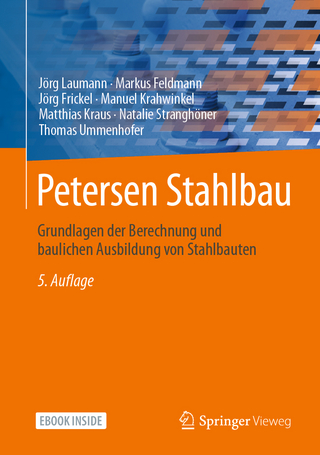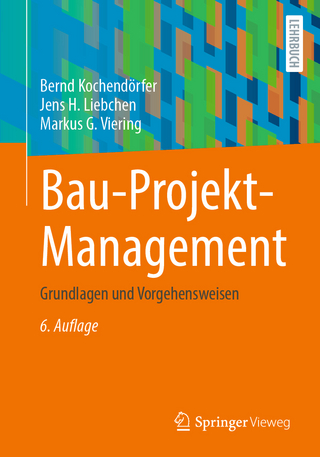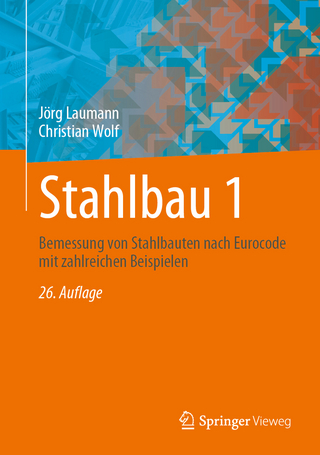
Trenchless Technology: Pipeline and Utility Design, Construction, and Renewal, Second Edition
McGraw-Hill Education (Verlag)
978-1-260-45873-2 (ISBN)
A fully updated guide to no-dig engineering and trenchless technology
This thoroughly revised reference covers the latest techniques and materials for high-demand trenchless technology in underground projects. Written by recognized experts in the field, Trenchless Technology: Pipeline and Utility Design, Construction, and Renewal, Second Edition offers clear explanations of the full range of trenchless technologies and pertinent regulations. You will get complete details on new tools, techniques, and analysis methods and discover how to choose between them. The information contained in this guide can save you thousands of dollars in costs and weeks of surface disruptions.
Coverage includes:
Planning and design considerations for trenchless construction and renewal methods
Pipe materials
Horizontal auger boring
Pipe ramming
Pipe/box jacking
Pilot Tube Microtunneling
Utility tunneling
Direct Pipe
Horizontal directional drilling
Cured-in-place and close-fit pipes
Sliplining and in-line replacements
Lateral renewal and localized repairs
Modified sliplining
Spray applied pipe lining
Sewer manhole renewal
Thermoformed pipe
Innovative applications
Director, Center for Underground Infrastructure Research (CUIR) University of Texas at Arlington, Texas
Foreword
Foreword to First Edition
Preface
1 Overview and Comparison of Trenchless Technologies
1.1 Introduction
1.2 Two Main Divisions of Trenchless Technology Methods
1.3 Trenchless Construction Methods (TCMs)
1.4 Trenchless Renewal Methods (TRMs)
1.5 Summary
2 Social Costs of Utility Construction: A Life Cycle Cost Approach
2.1 Cost of a Project
2.2 Preconstruction Costs
2.3 Construction Costs
2.4 Postconstruction Costs
2.5 Calculating Social Costs
2.6 Estimating Cost of Traffic Disruptions
2.7 Reducing Social Costs
2.8 Summary
3 Pipeline Asset Management, Condition Assessment, and Cleaning
3.1 Background
3.2 Asset Management
3.3 Causes of Pipeline Deterioration
3.4 Pipeline Inspection: Gravity Sewer Pipe
3.5 Pipeline Inspection: Pressure Pipe
3.6 Acoustic Emission Testing (AET)
3.7 Tethered and Untethered Transmission Main Leak Location
3.8 Pipeline Cleaning Methods
3.9 Gas and Hazardous Liquid Asset Management
3.10 External Corrosion
3.11 Internal Corrosion
3.12 Inline Inspection
3.13 Third Party Damage Prevention
3.14 Surveys and Patrols
3.15 Advanced Leak Detection
3.16 Emerging Technologies
3.17 Acknowledgement
4 Design Considerations for Trenchless Pipeline Construction Methods
4.1 Introduction
4.2 Surface Survey
4.3 Subsurface Investigations
4.4 Alignment Considerations
4.5 Calculating Jacking Force in Pipe Jacking and Microtunneling
4.6 Summary
5 Design Considerations for Trenchless Renewal Methods
5.1 Introduction
5.2 TRM Selection Process
5.3 Selection of a Renewal Method Based on Existing Pipe Conditions
5.4 Selection of a Renewal Method Based on Site and Project Conditions
5.5 Selection of a Renewal Method (a Six-Step Process)
5.6 General Design Considerations
5.7 Structural Design of CIPP
6 Pipe Materials for Trenchless Technology
6.1 Introduction
6.2 Pipe-Soil Interaction
6.3 Pipe Selection Considerations
6.4 Cement-Based Pipes
6.5 Vitrified Clay Pipe
6.6 Plastics Pipes
6.7 Metallic Pipes
6.8 Corrosion Protection
6.9 Acknowledgments
7 Horizontal Auger Boring (Bore and Jack)
7.1 Introduction
7.2 Brief History
7.3 Method Description
7.4 Cradle-Type Horizontal Auger Boring
7.5 Main Features and Application Range
7.6 Guidance Systems
7.7 Hybrid Methods
8 Pipe Ramming
8.1 Introduction
8.2 Method Description
8.3 Main Features and Application Range
8.4 Effects of Pipe Ramming on Surrounding Environment
9 Pipe/Box Jacking and Utility Tunneling
9.1 Introduction to Pipe Jacking
9.2 Method Description
9.3 Main Features and Application Range
9.4 Introduction to Utility Tunneling
9.5 Method Description
9.6 Main Features and Application Range
10 Horizontal Directional Drilling
10.1 Introduction and Background
10.2 HDD Classifications
10.3 Method Description
10.4 Main HDD Features and Application Range
10.5 Acknowledgment
11 Microtunneling Methods
11.1 Introduction
11.2 Method Description
11.3 Microtunneling Process
11.4 Main Features and Application Range
12 Pilot Tube
12.1 Introduction
12.2 Method Description
12.3 Main Features and Application Range
12.4 Advantages
12.5 Limitations
12.6 Acknowledgment
13 Direct Pipe
13.1 Introduction and Background
13.2 Method Description
13.3 Main Features and Application Range
13.4 Hydraulic Fracture Analysis for Direct Pipe
13.5 Case Study
13.6 Review Questions
13.7 Acknowledgments
14 Cured-in-Place-Pipe
14.1 Introduction
14.2 Site Compatibility and Applications
14.3 Main Characteristics
14.4 Method Description
14.5 Major Advantages
14.6 Major Limitations
14.7 Case Study
15 Sliplining
15.1 Introduction
15.2 Site Compatibility and Applications
15.3 Main Characteristics
15.4 Sliplining Methods
15.5 Installation
15.6 Design Considerations
15.7 Sliplining Gas Lines
15.8 Advantages
15.9 Limitations
15.10 Case Study: Large Diameter Segmental Sliplining
16 Close-fit Pipe
16.1 Introduction
16.2 Close-fit Pipe Applications
16.3 Method Description
16.4 Quality Documentation
16.5 Advantages
16.6 Limitations
17 In-line Replacement
17.1 Introduction
17.2 Pipe Bursting Methods
17.3 Pipe Removal Methods
17.4 Method Applicability
17.5 Construction Considerations
17.6 Advantages
17.7 Limitations
18 Service Lateral Renewal
18.1 Introduction
18.2 Service Lateral Renewal Methods
18.3 Advantages
18.4 Limitations
19 Localized Repair
19.1 Introduction
19.2 Primary Characteristics
19.3 Robotic Repairs
19.4 Grouting
19.5 Internal Seal
19.6 Point CIPP
20 Modified Sliplining
20.1 Introduction
20.2 Spiral Wound Lining (SWL)
20.3 Panel Lining (PL)
20.4 Fiber Reinforced Polymer (FRP) Linings
20.5 Acknowledgment
21 Spray Applied Pipe Linings
21.1 Introduction
21.2 Material Type and Purpose
21.3 Installation Process
21.4 Inspection and Testing
21.5 Acknowledgment
22 Thermoformed Pipe
22.1 Introduction
22.2 Thermoformed Pipe Applications
22.3 Construction Considerations
22.4 Quality Assurance and Documentation
22.5 Advantages
22.6 Limitations
23 Sewer Maintenance Hole Renewal
23.1 Introduction
23.2 Maintenance Hole Components and Typical Problems
23.3 Maintenance Hole Inspection and Safety Issues
23.4 Classification of Maintenance Hole Problems and Selection of Proper Method
23.5 Decision Support Tool for Maintenance Hole Rehabilitation
23.6 Summary of Maintenance Hole Renewal Methods
23.7 Advantages and Limitations of Maintenance Hole Renewal Methods
Glossary
Acronyms and Abbreviations
Organizations Related to Trenchless Technology
Conversion Table
Bibliography
References
Index
| Erscheinungsdatum | 21.09.2020 |
|---|---|
| Zusatzinfo | 250 Illustrations |
| Verlagsort | OH |
| Sprache | englisch |
| Maße | 196 x 244 mm |
| Gewicht | 1198 g |
| Themenwelt | Technik ► Bauwesen |
| Technik ► Umwelttechnik / Biotechnologie | |
| ISBN-10 | 1-260-45873-3 / 1260458733 |
| ISBN-13 | 978-1-260-45873-2 / 9781260458732 |
| Zustand | Neuware |
| Informationen gemäß Produktsicherheitsverordnung (GPSR) | |
| Haben Sie eine Frage zum Produkt? |
aus dem Bereich


